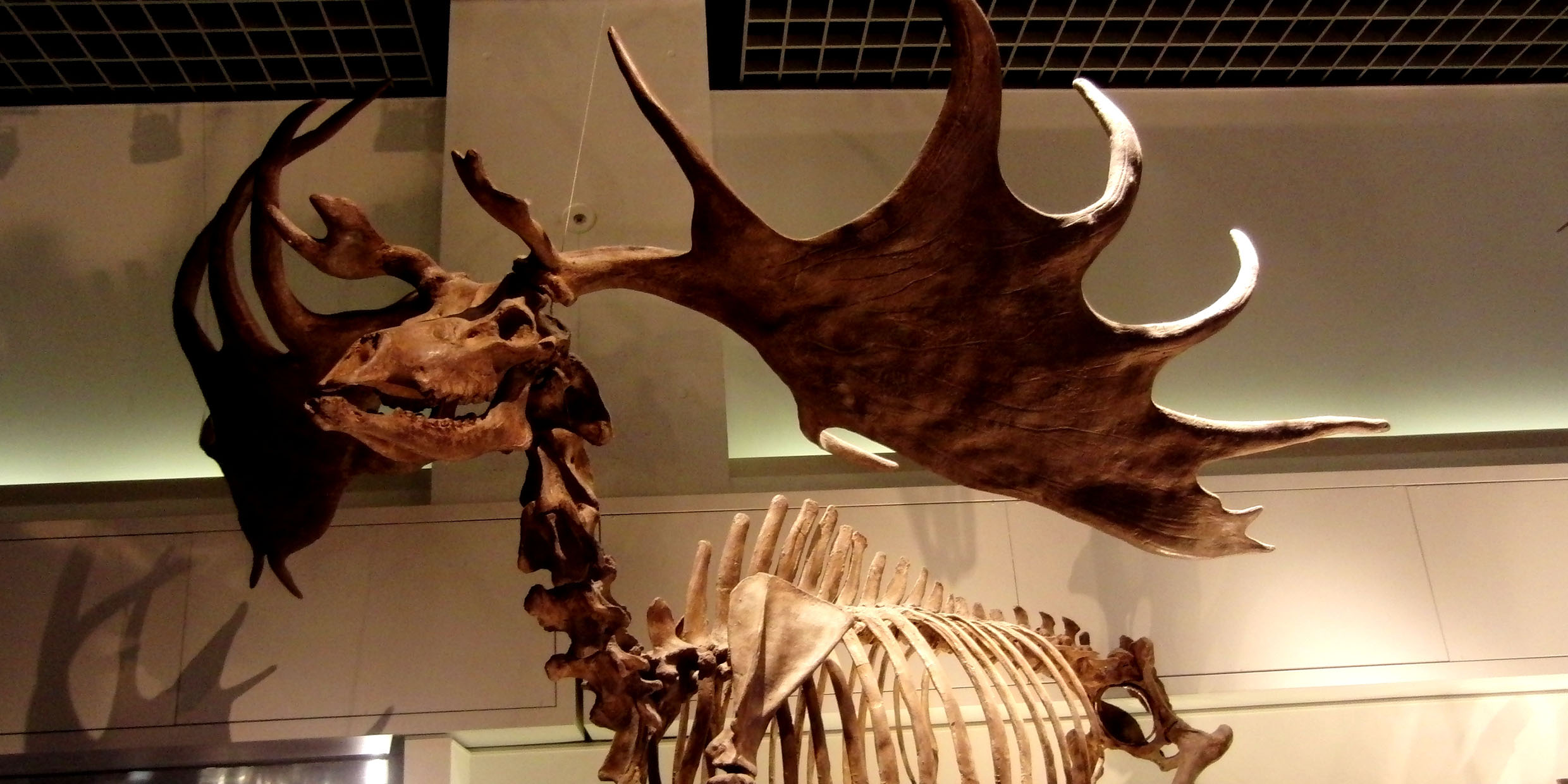Originally published 1 August 2000
DINGLE, IRELAND — The Irish love their turf — poet Seamus Heaney’s “kind, black butter.” Sliced and dried, it makes a lovely, aromatic fuel. The turf bogs are also wonderful repositories of Irish history.
The same waterlogged, anaerobic conditions that prevent vegetative matter from completely decaying preserve almost anything buried in a bog — medieval chalices of magnificent richness, Viking jewelry, crocks of actual butter from the age of saints and scholars, forts and roads of Fenian warriors, treasure hoards from the bronze age, and giant oak trees from long-vanished forests. Not least among the wonders of the bog are skeletons of the misnamed, absurdly-helmeted great Irish elk.
Misnamed because the Irish elk is neither elk nor exclusively Irish. Its closest relative is the fallow deer. And its range during the ice ages included Europe, northern Asia, and north Africa — far afield from Ireland. But it was out of Irish bogs that the first and largest specimens of the animal were taken in the 17th and 18th centuries, and thus its moniker.
The great Irish elk, Megalocerus giganteus, was 7 feet high at the shoulders, with antlers that measured an eye-popping 12 feet from tip to tip, with great flat, forward-facing plates — antlers bigger than the beast itself. Just listen to those Latin modifiers: mega‑, giganteus. This guy had a head of horns.
Skulls of Irish elks with their gargantuan headgear decorate castles and hunting lodges all over Ireland. Skeletons have been set up in Irish museums, were Irish men and women come to gape and praise. Seamus Heaney called one such specimen “an astonishing crate full of air.”
Astonishing indeed. The stupendous antlers above the stone hearths and in the museums lend an air of outsized pride to this little green island. The early 20th-century Irish naturalist, Robert Lloyd Praeger, went so far as to suggest that the Irish elk should crown the nation’s coat of arms.
A century ago, the extinction of the Irish elk was attributed to something called orthogenesis. The idea was that some animals have built-in tendencies to evolve in certain ways. For the Irish elk, this was a trend toward larger antlers. Presumably, the poor beast had no control over the burgeoning size of its cranial appendages; from generation to generation they just “growed and growed” until the animal could no longer hold its head erect or walk between the trees without getting snared.
Biologists today have another explanation for the big antlers — runaway sexual selection. Female Irish elks, it seemed, preferred males with big antlers. So the fellow with a slightly larger set of horns attracted the most mates, and therefore his large-horn genes passed on to succeeding generations. With antlers getting bigger and bigger, one wonders how those grotesquely top-heavy males that the females found so attractive managed to do the manly thing.
But were the big antlers implicated in the animal’s demise?
During the glacial age, Ireland was mostly covered with ice. Then, about 11,000 years ago, the climate warmed and the ice retreated to its arctic fastnesses. Briefly, while a large volume of ice was still on more northerly lands, sea level was lower and Ireland was connected to Britain and Europe. Across these dry passages, a few animals recolonized post-glacial Ireland, including the Irish elk. As the retreating glaciers continued to shrink, the sea rose and Ireland was cut off from its neighbors.
Like many other giant animals of the ice age, including the woolly mammoth and mastodon, the Irish elk became extinct at about the time the glaciers were retreating. Did these great beasts fail to adapt to warmer climes?
Or were the Irish elks victims of human overkill? This was about the same time that our ancestors were developing effective new hunting technologies, including spears with sharp stone tips.
Three British paleontologists recently reported in Nature the radiocarbon ages for several Irish elk skeletons from the Isle of Man in the Irish Sea between Britain and Ireland. Their specimens date from about 9,000 years ago, a good millennium-and-a-half later than previously measured dates in Ireland, and a thousand years after the Isle of Man became isolated from Britain and Ireland by rising seas.
This would suggest hunting rather than changing climate as the cause of extinction, but the British researchers are properly cautious about drawing definite conclusions.
Whatever the reason for the extinction, Irish people are grateful for the demise of big-horned elk from the bogs. This is a land of diminutive fauna. Field mouse. Pygmy shrew. Stoat. Fox. Hedgehog. Badger. Not much here to excite big-eyed awe. No broad-shouldered, he-man mammals in Ireland. No girth and brawn.
But look at the horns on that creature in the bogs. That swaggering, staggering, prodigiously-antlered cock-of-the-walk — the great Irish elk.



